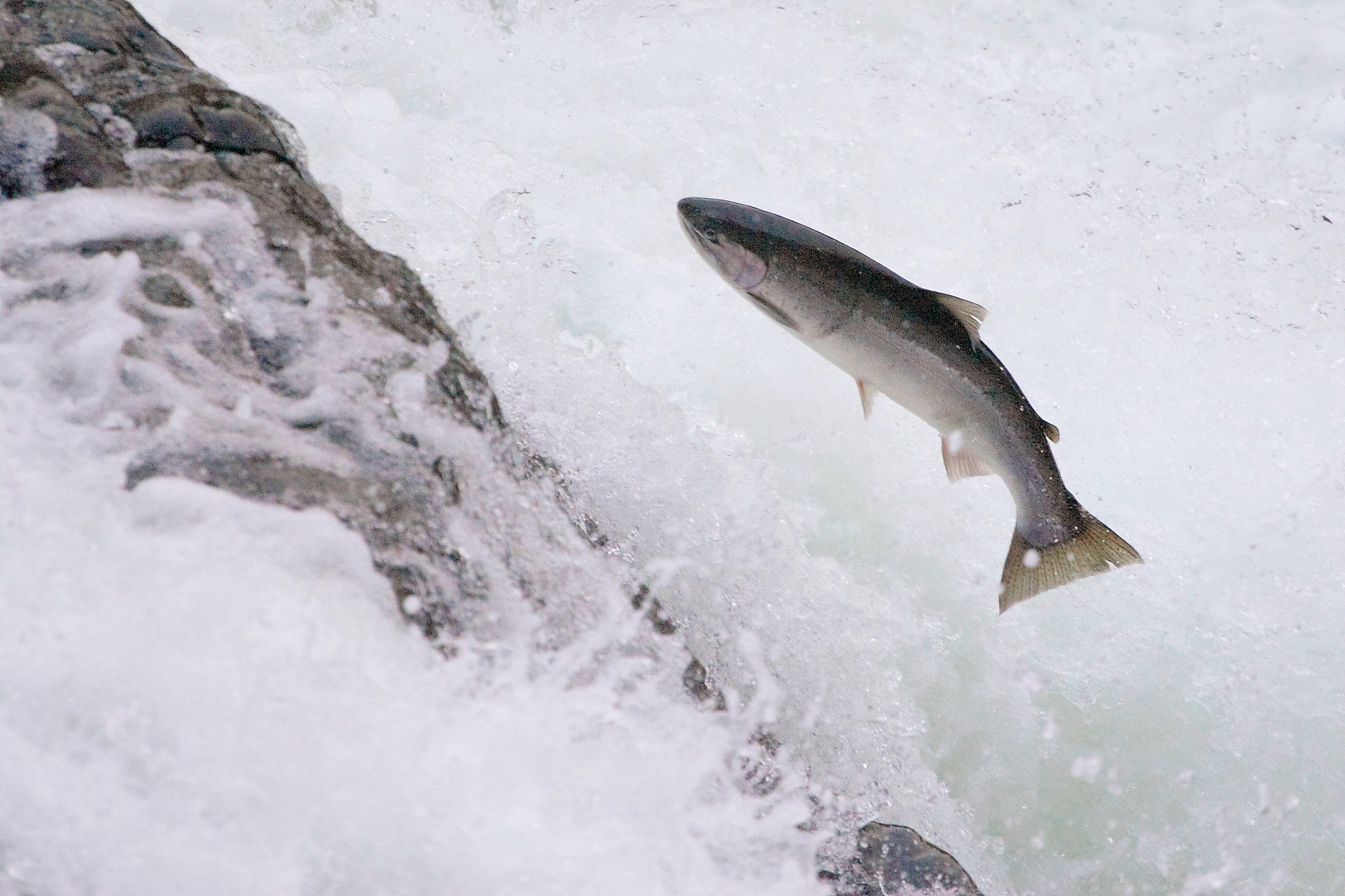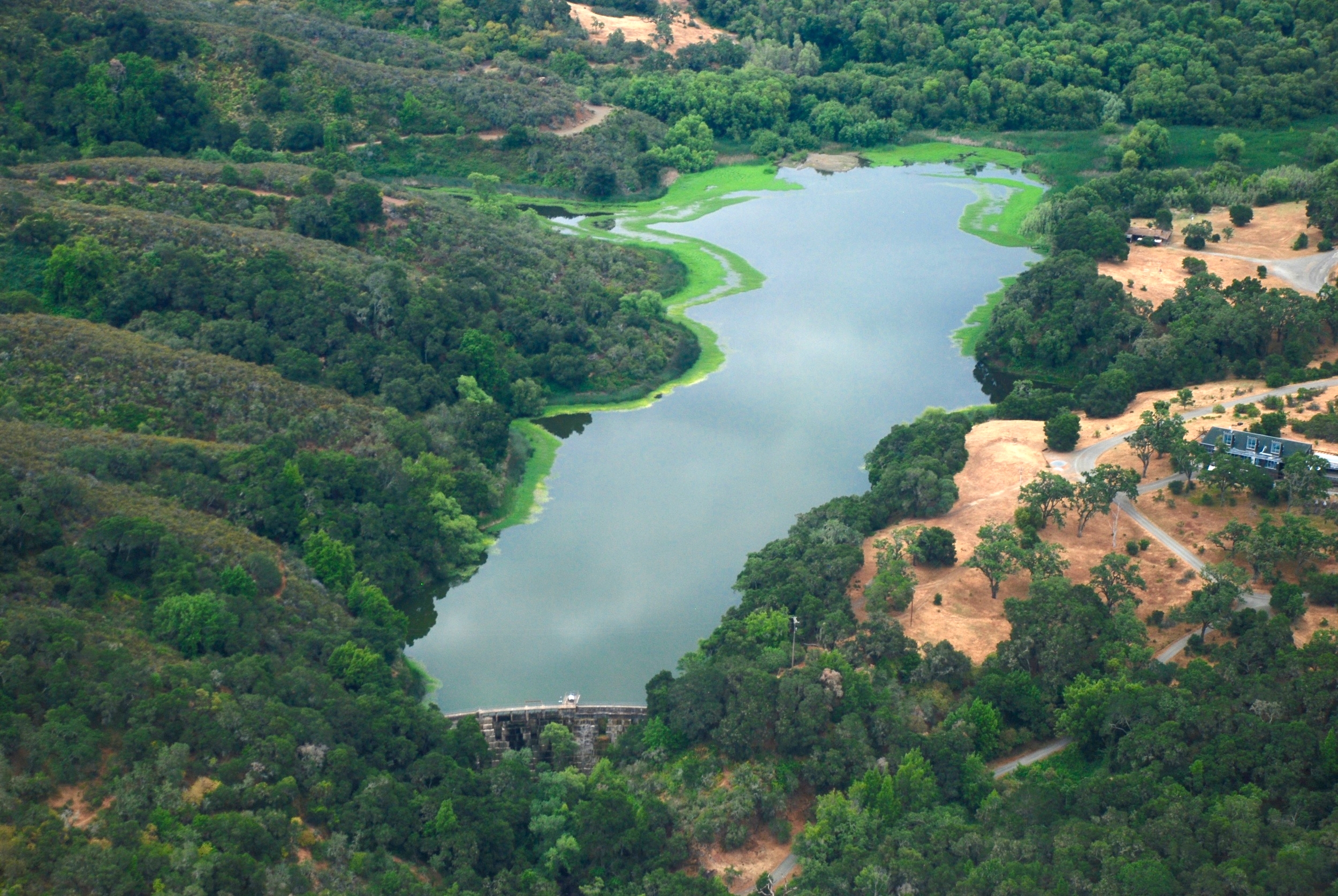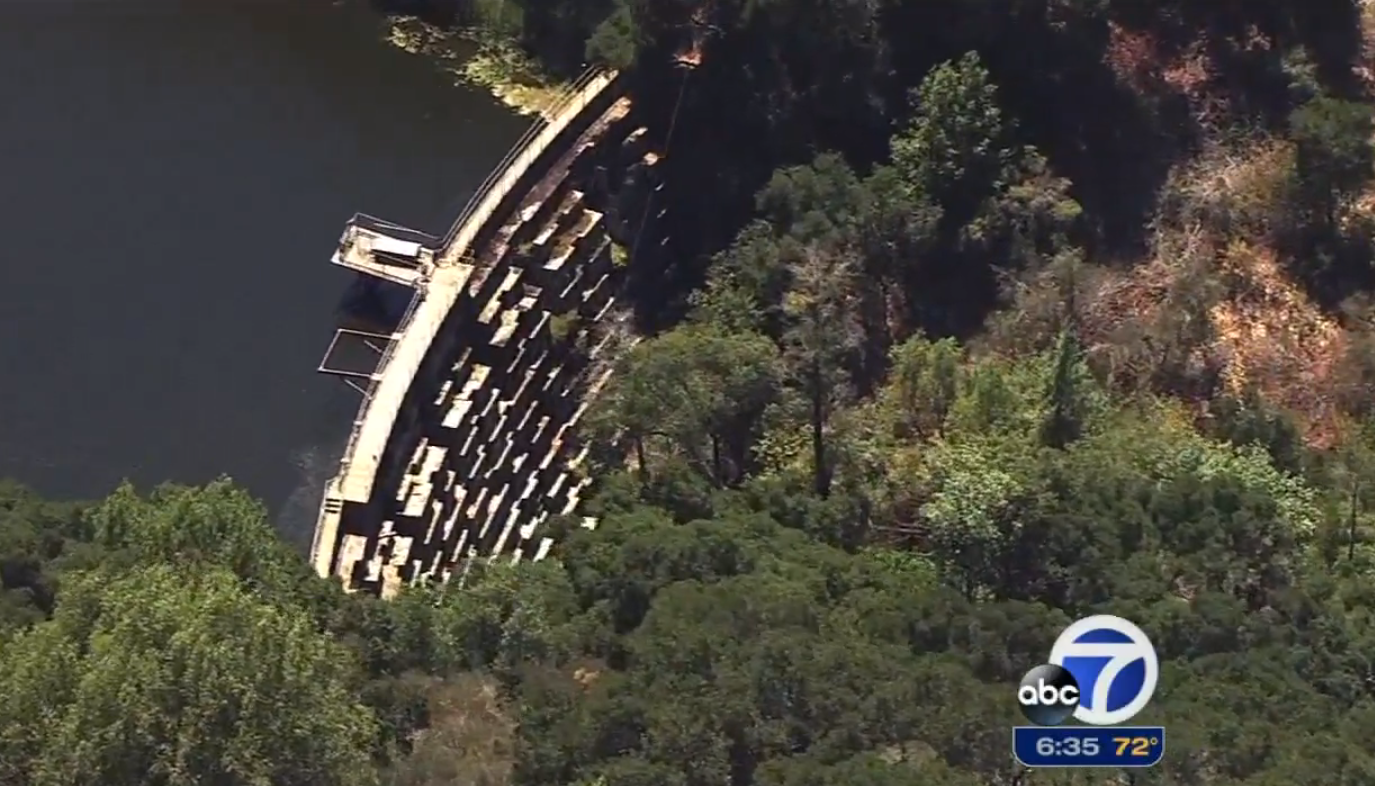






"Sooner or later Searsville Dam must come down, and the whole San Francisquito Creek watershed can be treated as the ecological treasure that it is."
- Pete McCloskey, former U.S. Congressman and co-author of the Endangered Species Act; Stanford University Law School alumnus
RECENT NEWS:
January 2017: Hewlett Foundation gives $50 million for dam removal
The first three projects to receive grant funding are the Matilija Dam in Ventura, California; a series of dams and obstructions in Oregon's Rogue River basin; and the Nelson Dam on the Naches River in Yakima, Washington.
Not on the current list is the dam on Corte Madera Creek that created Searsville Lake, a private lake owned by Stanford University in the Jasper Ridge Biological Preserve.
Opponents of that dam say its removal would improve the health of the San Francisquito Creek watershed, including restoring a route for steelhead trout to swim upstream and spawn.
Among those opponents is Matt Stoecker, director of Beyond Searsville Dam, who called the Open Rivers Fund progressive and collaborative "where the dam owner supports transitioning away from an obsolete dam and towards less harmful options. ... When Stanford is ready to move forward with Searsville Dam removal, multiple funds and grant programs like this are poised to support them."
In a 2015 report, Stanford said that while it valued keeping the 65-foot-tall, 275-foot-wide dam up for flood control, it would consider steps to allow passage of fish.
Read more at: http://www.almanacnews.com/print/story/2017/01/04/hewlett-foundation-gives-50-million-for-dam-removal
June 2016: This Man is Hooked on Freeing Western Rivers from Deadbeat Dams
As a kid, Matt Stoecker loved to explore and fish in the clear-flowing creek running through his hometown of Portola Valley, California. One day, he hiked far downstream and saw the waters wend into a stagnant, brown reservoir formed by the Searsville Dam. Walking around to face the massive structure, Stoecker watched a huge silver fish—“the size of my arm”—break the surface of the pool in front the dam. The steelhead leapt five feet in the air, smashed its head against the concrete wall, and fell back into the water.
Even as a child, “I knew something was wrong. I was mad,” Stoecker says. “I still feel all of these emotions recalling that determined trout unable to get home.”
Stoecker, an ecologist and 2015 National Geographic Adventurer of the Year, now fights to tear down Searsville Dam and other “deadbeat dams” across the western U.S. The movement was illustrated by the award-winning 2014 documentary DamNation, which he produced with Felt Soul Media's Ben Knight and Travis Rummel and Patagonia. Stoecker has shepherded recent negotiations and agreements to remove several dams over the next few years, including Lagunita Dam, also owned by Stanford University, and Matilija Dam in Ventura County, California.
Scientific evidence shows that ecosystems can rebound once dams are removed, as seen recently in the recovery of Washington State’s Elwha River after the Glines Canyon Dam was removed in August 2014, the largest dam removal project in U.S. history. The free-swimming fish bring nutrients from the ocean to the inland watershed and spur the resurgence of rivers, wetlands, and forests where there were artificial lakes. “Steelhead swam through the giant hole blasted in the base of Condit Damon the White Salmon River before the bulk of the dam was even removed,” Stoecker says. “With each new dam that is taken down, it become increasingly clear that he benefits from dam removal are instantaneous, far reaching, and lasting.” And he argues that doing nothing is not an option.
Read more at: http://www.nationalgeographic.com/adventure/features/freeing-american-rivers-from-deadbeat-dams/
Obsolete Searsville Dam will continue to damage San Francisquito Creek
American Rivers / May 7, 2015
In a disappointing decision, Stanford announced that it has preliminarily chosen to cut a hole at the bottom of Searsville dam as its preferred option for allowing steelhead to travel past the dam, but it will study the option further before making a final decision.
The dam has blocked threatened steelhead trout from reaching miles of good habitat and has dried up the creek since about 1892. Now the reservoir is over 90 percent filled in with sediment and is no longer needed to supply water to the golf course and landscaping. We appreciate that Stanford has chosen to abandon Searsville as the water source for its golf course and landscaping, but we believe cutting a hole in the dam is inferior to full dam removal with respect to achieving Stanford’s stated goals.
[...]
American Rivers, Beyond Searsville Dam, California Trout, and dozens of other conservation groups and businesses have repeatedly called for dam removal. Studies conducted by Stanford over the past two years demonstrate that the dam can be safely removed and improve flood safety for downstream communities. American Rivers named San Francisquito Creek one of America’s Most Endangered Rivers of 2014 because of Searsville Dam, and citizens have sent more than 25,000 letters to the university calling for dam removal.
Last month the California Water Resources Control Board, from whom Stanford must get a permit for any Searsville project, reiterated their support for dam removal and raised concerns about other options, including cutting a hole in the dam. The Town of Portola Valley, just upstream of the dam, requested that Stanford restore “unimpeded” wildlife migration and watershed heath; outcomes that can only be accomplished with dam removal.
The process is by no means over.
Read more at: http://www.americanrivers.org/blog/obsolete-searsville-dam-will-continue-to-damage-san-francisquito-creek/
Water board tells Stanford it supports removing Searsville Dam; Endangered species threatened by the dam
Palo Alto Online / April 2, 2015
The San Francisco Bay Regional Water Quality Control Board has sent Stanford University a letter saying the agency supports "alternatives that focus on dam removal" as the university moves toward a decision on what to do with Searsville Dam and its reservoir.
"We have been, and continue to be, supportive of alternatives that focus on dam removal," the letter says. The letter says the dam "remains a complete barrier to steelhead migration, greatly reducing the amount of habitat that is accessible, and placing this steelhead population at much greater risk of extinction."
Read more at: http://www.paloaltoonline.com/news/2015/04/02/water-board-tells-stanford-it-supports-removing-searsville-dam
Rivers Recover Rapidly Once Dams Are Gona, Study Finds
Oregon Public Broadcasting / April 30, 2015
A new study sums up what scientists now know about the environmental effects of removing dams from rivers. It concludes that rivers and fish respond quickly after a dam is removed, and the results are mostly positive.
“Heraclitus has said you can’t step in the same river twice,”said study co-author Gordon Grant. “Well, you don’t get exactly the same river back after you take a dam off it that you had before, but you can come pretty close. In some cases, it can even be difficult to identify in just a few years where the dam was.” Rivers often disperse the extra sediment from behind a dam within weeks or months of dam removal, the study finds. Migratory fish move swiftly to recolonize newly accessible habitat – at times swimming past the former dam site within a matter of days.
The research, published Thursday in the journal Science, compiles the findings of more than a hundred studies on individual dam removals.
Read more at: http://www.opb.org/news/article/rivers-recovery-rapidly-once-dams-are-gone-study-finds/
KALW 91.7 FM Public Radio / January 29, 2015
The Searsville Dam is causing big trouble on the peninsula. The 122-year-old, 65-foot-tall dam is closed to the public, hidden away on 1,200 acres owned by Stanford University.
“Searsville Dam has been Stanford's well kept, dirty little secret,” says attorney Christopher Sproul. [...] “It's here in California and close to these major metropolitan areas, we have this incredible wildlife. We can see these fish and a steelhead can jump up to fifteen feet in the air. I think to wipe out a fish that can jump over a fifteen foot barrier is unconscionable.”
Read more & listen to the story at:
http://kalw.org/post/stanford-considering-fate-century-old-dam-threatening-endangered-trout
Dare to be 100: DamNation; What Would John Gardner Say?
HuffPost Blog / November 17, 2014
Last night I had the opportunity to check out the important new documentary film DamNation, that has already won honors at first-rank film festivals nationwide. It is a precise retelling of the history of American dam building which reached a fever pitch in the early 1920s. Thousands were built all over America. It seems that no river or creek was exempt. The thirst for power jaded any consideration of unintentional consequences into the future which number many, but the worst offense to me is the desecration of some of our most precious ecosystems, particularly for the fish whose existence in a healthy stream and river bed is essential.
This grim development of thousands of dams, most of which originally were well intended, but are now mostly derelict remnants, has resulted in the havoc that has cost the lives of billions of fish who were thirsty for living space.
This issue was important but remote to me until last night, when my neighborhood gathered to view the release of this wonderful film. Right there, hidden but central to our neighborhood is the Searsville Dam, built in 1892, simply to abet the water supply of San Francisco, 30 miles to the north. Not surprisingly, such intention was never fulfilled. It was subsequently acquired by Stanford. This dam which sits astride the San Francisquito Creek has languished into disrepair. Its only present usage is to supply water for the Stanford University golf course. Meanwhile untold millions of migratory salmon are obstructed from their original habitat. Their existence is held hostage to the caprice of Stanford.
Stanford University is my home church and to millions of alumni, faculty, and other neighbors and friends. All of us are immensely proud of its grandeur. One of its most esteemed members was John Gardner, who is still listed in its pantheon. John delivered the commencement address at the 100th graduation. Stanford accorded him their highest distinction that of the Uncommon Man. John served in Lyndon Johnson's cabinet as Secretary of HEW 1963-1969, and among other things brought in Medicare.
[...]
I often reflect what would John have to say about X,Y or Z. What would John Gardner say about Stanford's dereliction in preserving this decrepit relic so that it can water its golf course? I am certain that John, like thousands of others, would cringe in embarrassment. Stanford, please deserve your exalted reputation in society, and tear down the dam.
Read more at:
http://www.huffingtonpost.com/walter-m-bortz-ii-md/dare-to-be-100-dam-nation_b_6172930.html
Stanford's Searsville Dam blocks fish, spurs debate
Stanford University is finding itself at the center of an unlikely environmental battle. It centers on an aging dam and the barrier it creates for native fish. A decision on whether to tear it down is expected later this year.
Lush trees grow along the banks of San Francisquito Creek Palo Alto, but there is no water this time of year. That's because a dam, owned by nearby Stanford University, keeps it from flowing.
Read more at:
http://abc7news.com/education/stanfords-searsville-dam-blocks-fish-spurs-debate/218357/
As dams fall, rapid changes on Elwha River
WASHINGTON TIMES / July 5, 2014
The final chunks of concrete are expected to fall this September in the nation’s largest dam-removal project, but nature is already reclaiming the Elwha River on Washington’s Olympic Peninsula.
So much sediment, once trapped in reservoirs behind two hydroelectric dams, has flowed downstream that it has dramatically reshaped the river’s mouth, replenished eroding beaches and created new habitat for marine creatures not observed there in years.
Read more at:
http://www.washingtontimes.com/news/2014/jul/5/as-dams-fall-rapid-changes-on-elwha-river/?page=all
Feds sued over Stanford's Searsville Dam
PALO ALTO ONLINE / March 12, 2014
Corte Madera Creek, below the Searsville Dam, on Feb. 28 shows a bed of angular rocks that environmentalists say are not suitable for steelhead trout.
Read more at: http://www.paloaltoonline.com/news/2014/03/12/feds-sued-over-stanfords-searsville-dam
Environmentalists file suit against Stanford's operation of Searsville Dam
STANFORD DAILY / January 30, 2013
Two environmental groups filed suit against Stanford on Tuesday, alleging that the University’s operation of the Searsville Dam– and the ensuing water diversion– has harmed local steelhead trout populations.
Despite an ongoing investigation of the same issue by the National Oceanic and Atmospheric Administration (NOAA), University administrators dismissed the lawsuit filed by the Ecological Rights Foundation (ERF) and Our Children’s Earth Foundation (OCE).
Read more at: http://www.stanforddaily.com/2013/01/30/environmentalists-file-suit-against-stanfords-operation-of-searsville-dam/
May 2016: Undamming this major U.S. River is opening a world of possibility for native cultures and wildlife
Flowing over 250 miles from the high desert of southern Oregon through the Cascades Mountains before emptying out into the Pacific Ocean in northern California, the Klamath River and its Coho and Chinook salmon and steelhead runs were vital to Native American tribes for thousands of years before settlers arrived.
But within decades of their arrival there would be half a dozen dams constructed on the river, effectively blocking salmon and steelhead migrations on what was once the third-highest salmon producing river on the West Coast. The river that was fabled for its millions of salmon each season saw significant decreases following dam construction.
But now after nearly a century, an agreement has finally been reached to remove four dams on the Klamath River by 2020 as the first step towards restoring the salmon and steelhead migrations in the Klamath basin.
Read more at: http://fusion.net/story/297901/undamming-major-west-coast-river/
July 2015: Local environmental groups seek injunction ordering Stanford to provide lifeline to endangered steelhead trout during drought
The requested measures include allowing bypass flows to support water levels downstream, as required by State and Federal law, which has never been implemented by Stanford.
In past years, Stanford University has degraded fish habitat in San Francisquito Creek and its watershed by diverting significant volumes of water to irrigate its golf course and other campus landscaping. The 125-year old Searsville Dam blocks native salmonids from accessing high-quality habitat upstream in the Portola Valley area, and continues to degrade fish habitat downstream of the dam.
June 2015: Stanford study confirms mass extinction event; urges swift action to restore habitat and stop resource exploitation for financial gain
Stanford University Woods Institute; Science Advances Journal / June 19, 2015
[...] Even under our assumptions, which would tend to minimize evidence of an incipient mass extinction, the average rate of vertebrate species loss over the last century is up to 114 times higher than the background rate. Under the 2 E/MSY background rate, the number of species that have gone extinct in the last century would have taken, depending on the vertebrate taxon, between 800 and 10,000 years to disappear.
These estimates reveal an exceptionally rapid loss of biodiversity over the last few centuries, indicating that a sixth mass extinction is already under way. Averting a dramatic decay of biodiversity and the subsequent loss of ecosystem services is still possible through intensified conservation efforts, but that window of opportunity is rapidly closing.
Read more at: http://advances.sciencemag.org/content/1/5/e1400253.full
https://woods.stanford.edu/news-events/news/mass-extinction-here
Stanford University identifies two ways to send water through, or around, the dam
Palo Alto Online / May 4, 2015
The alternatives would also allow the university to continue to use water from the creeks. [...] "This recommendation creates a new point of diversion downstream and shifts water storage from Searsville to Felt Reservoir.
[...] "The recommendation regarding water diversion and storage is intended to preserve Stanford's rights to creek water diversion and storage considering the effects of climate change, population growth, and drought on the region's water sources," the committee wrote.
But not everyone agrees with the steering committee's choices. Two key organizations still say removing the dam is the only acceptable action. "Poking a hole in an unneeded dam or letting it fill in with sediment are not viable solutions. These are ineffective Band-Aids that are unlikely to secure permits or attract funding support," said Matt Stoecker, a biologist for Beyond Searsville Dam and a member of the advisory committee.
Read more at: http://www.paloaltoonline.com/news/2015/05/01/searsville-dam-will-stay-for-now-endangered-fish-to-get-more-water
Portola Valley council supports alternatives to Searsville Dam
The Almanac / February 4, 2015
The Portola Valley Town Council has put itself on record supporting steps that would create an unimpeded migratory path for ocean-going fish, such as steelhead trout heading home to the San Francisquito Creek watershed in the Santa Cruz Mountains.
Read more at:
http://www.almanacnews.com/news/2015/02/04/portola-valley-council-supports-alternatives-to-searsville-dam
REPORT: Steelhead in San Francisquito Creek would recover with Dam Removal
San Jose Mercury News / December 20, 2014
Federally threatened steelhead trout could return to the creeks upstream of Stanford University's Searsville Dam within weeks if the structure is taken down, according to a new report from a biologist and proponent of the dam's removal.
Matt Stoecker based his assessment primarily on the widespread presence of rainbow trout, a close cousin of the oceangoing steelhead, in Corte Madera Creek and its tributaries. The fish rely on the same kind of freshwater habitat early in their life cycle, he said.
"The big takeaway is that the federally threatened San Francisquito Creek steelhead are ready to return to high quality, historically accessible habitat upstream of the impassable Searsville Dam if and when Stanford will let them," Stoecker wrote in an email to The Daily News. "The high quality spawning and rearing habitat is still there, the native rainbow trout are still there, and adult steelhead are still trying to get back upstream, but Stanford's unnecessary dam won't let them."
Read more at:
http://www.mercurynews.com/my-town/ci_27177049/report-steelhead-san-francisquito-creek-would-recover-dams
Stanford should abandon the Searsville Dam
Stanford Daily / December 21, 2014
My boys and I have hiked up and down San Francisquito Creek hundreds of times. Though we’ve caught crawdads and skipped rocks, we also found dead steelhead trout stranded near a stagnant pool that was left behind as the creek ceased to flow during the late spring of 2013. Other steelhead have encountered the same fate in recent years. California’s wild steelhead are a highly resilient species, but they are struggling to survive in Bay Area streams and elsewhere due to widespread loss of adequate habitat and diversion of critical flows.
Stanford University’s 125-year old Searsville Dam and other water diversions have kept the San Francisquito Creek much drier than it was for years before Searsville was built. When water was more plentiful on this and other creeks, thousands of steelhead and salmon would swim many miles upstream from the San Francisco Bay to spawn eggs in the headwater streams of the San Francisquito watershed. Today, the creek’s native steelhead population is listed as threatened, while the University continues to block their upstream migration by holding back water from local streams in order to irrigate its water-intensive golf course.
Read more at:
http://www.stanforddaily.com/2014/12/21/stanford-should-abandon-the-searsville-dam/
As world's largest dam removal project is completed, fish already returning
The Elwha River, which courses through northwest Washington state’s Olympic Peninsula, once hosted enormous runs of chinook and red salmon. But that came to an end in 1913 with the building of the Elwha River dam.
“There's nothing more painful than to see red salmon banging up against the dam, which is what you saw when you went there,” said Interior Secretary Sally Jewell, at the annual meeting of the Society of Environmental Journalists in New Orleans on September 5, 2014.
Read more at:
http://www.newsweek.com/worlds-largest-dam-removal-completed-fish-already-returning-269231
Stanford dam blamed for diverting water from creek
Built in 1892 and choked nearly to the brim with sediment, the [Searsville Dam] blocks the migration of one of the bay's last remaining populations of native steelhead trout, the group American Rivers said in a report being released Wednesday. The reservoir irrigates campus lawns and the university golf course.
Read more at:
http://www.sfgate.com/science/article/Stanford-dam-blamed-for-diverting-water-from-creek-5387829.php
Stanford ordered to permit outside group inspection of Jasper Ridge preserve
STANFORD DAILY / March 4, 2014
A federal judge recently ordered Stanford to permit two environmental groups to inspect the Jasper Ridge Biological Preserve, following the filing of lawsuits last year over the University’s operation of the Searsville Dam.
Read more at: http://www.stanforddaily.com/2014/03/04/stanford-ordered-to-permit-outside-group-inspection-of-jasper-ridge-preserve/
Steelhead trout flopping around in dried up Palo Alto creek
It’s a pretty sorry sight to see a threatened steelhead trout flopping around without enough water.
But that’s what’s happening in San Francisquito Creek in Palo Alto, where the creek is drying out well before it should this year and jeopardizing the the most viable remaining native steelhead trout population in the Bay Area.
Read more at: http://baynature.org/articles/steelhead-trout-flopping-around-in-dried-up-palo-alto-creek/
Federal agency investigating Stanford's operation of Searsville Dam
SAN JOSE MERCURY NEWS / December 29, 2012
The National Marine Fisheries Service is investigating whether Stanford University's operation of Searsville Dam in San Mateo County is violating the Endangered Species Act.
NMFS INVESTIGATION UPDATE:
The Searsville investigation was closed due to lack of resources; NMFS' Lead Investigator noted that the case merits the agency's attention and requires further investigation.
Read more at: SaveStanfordSteelhead.org/legal-documents
“If we are to leave our children a better world, we must take steps now to create a sustainable environment. So it is critical that we model sustainable citizenship on our own campus.”
“Our treatment of animals will someday be considered barbarous. There cannot be perfect civilisation until man realises that the rights of every living creature are as sacred as his own.”
“Stanford’s behavior shames us all.”
“[T]he acceleration of this natural, more gradual, summer flow recession or the abrupt truncation of flows caused by the [Searsville] Diversion increases the likelihood of [steelhead] stranding. Furthermore, the presence of the Dam prevents steelhead from moving upstream.”
“While we will always honor Stanford’s history, we must not be afraid to outgrow old ideas. We must embrace the responsibility inherent in the founders’ words, and ensure that their University—our University—will continue to be one of the world’s great centers of learning and research.”
“Do it now, please. Do the right thing.”
“There is no pattern of use to suggest that the [Searsville] Diversion is operated according to water year type (i.e., higher diversions during wet years and less during dry years).”
“I hope that Stanford can commit to the removal of Searsville Dam and the restoration of the original wetlands in the area. I expect that the original wetlands supported just as many bats and other species of special concern as the current wetlands do.”
“How disappointing that Stanford has prioritized water for a golf course over protecting endangered fish. It is an outrageous situation at this point— Stanford has known about the issues for years and delayed meaningful actions to restore the watershed. Time to step up.”
“This dam is nonsensical. It eliminates habitat for threatened species, imposes significant risk to downstream residents (and thus probably should, and eventually will, be deemed a public nuisance if not taken down), while providing little to no benefit. It’s time for Stanford to take this dam down. If it doesn’t it will end-up not only on the wrong side of history but also in legal battle after legal battle. Stanford should turn what is now a dramatic stain on its environmental reputation into bright spot by taking this dam down and leading the fight to preserve this resource.”
“A special thanks to Matt Stoecker for his documentary film, “DamNation”. I hope that his efforts along with yours and everyone concerned will have a “ripple” effect which will result in action being taken to restore all the streams that support Earth’s ecosystems. ”
“I believe an institution of Stanford’s caliber should reconsider their position on this matter as it has great environmental benefit with so few drawbacks. Anadromous fish are endangered, and Stanford is removing habitat in order to water their golf course. I think this shows misplaced priorities.”
“Stanford has one of the most important dam-removal and ecosystem-restoration opportunities in the country, and can position itself as a leader in environmental stewardship and make huge progress in achieving its stated goal of being a more sustainable campus. Stanford has got to clean up their own backyard before people will take their sustainability and environmental message seriously. You are what you do, not what you say.”













![Stanford University Woods Institute; Science Advances Journal / June 19, 2015[...] Even under our assumptions, which would tend to minimize evidence of an incipient mass extinction, the average rate of vertebrate species loss over the last cent…](https://images.squarespace-cdn.com/content/v1/536bbb04e4b029a75390f942/1434748937404-U3VNI6844ZYHSF5KE0ZA/image-asset.png)
![Stanford University identifies two ways to send water through, or around, the damPalo Alto Online / May 4, 2015The alternatives would also allow the university to continue to use water from the creeks. [...] "This recommendation creates a new p…](https://images.squarespace-cdn.com/content/v1/536bbb04e4b029a75390f942/1431574711580-RR4WELD0XVA7MAM34VLA/image-asset.png)




![Stanford dam blamed for diverting water from creek SFGATE / April 9, 2014Built in 1892 and choked nearly to the brim with sediment, the [Searsville Dam] blocks the migration of one of the bay's last remaining populations of native steelhead tro…](https://images.squarespace-cdn.com/content/v1/536bbb04e4b029a75390f942/1410634541019-4QK1UEAB7RSXFYLXHOV5/image-asset.png)



